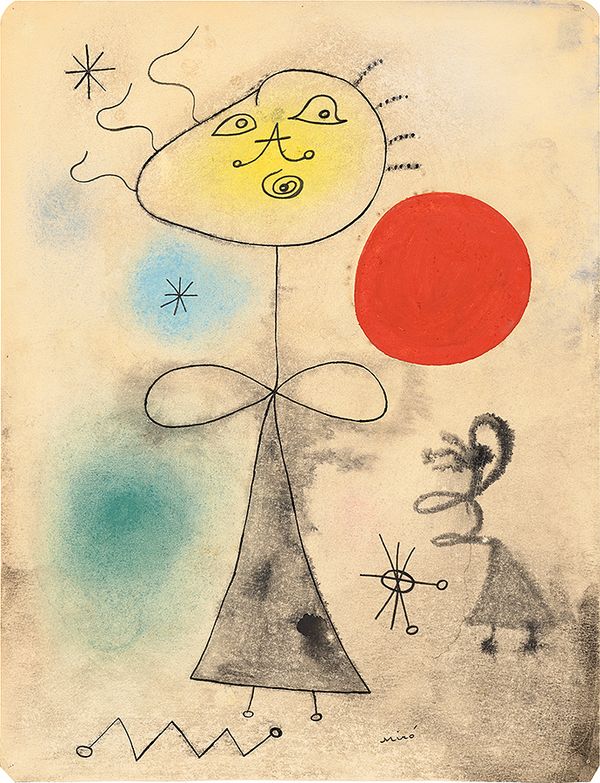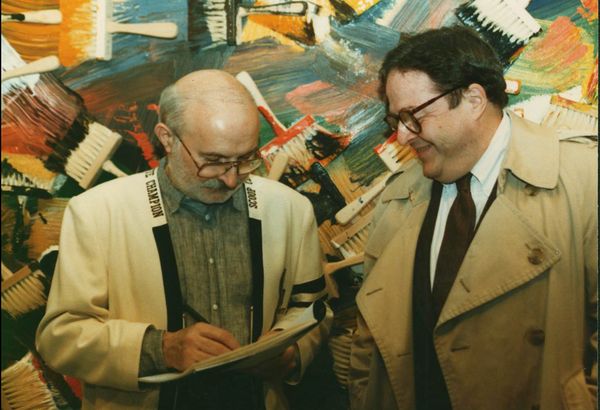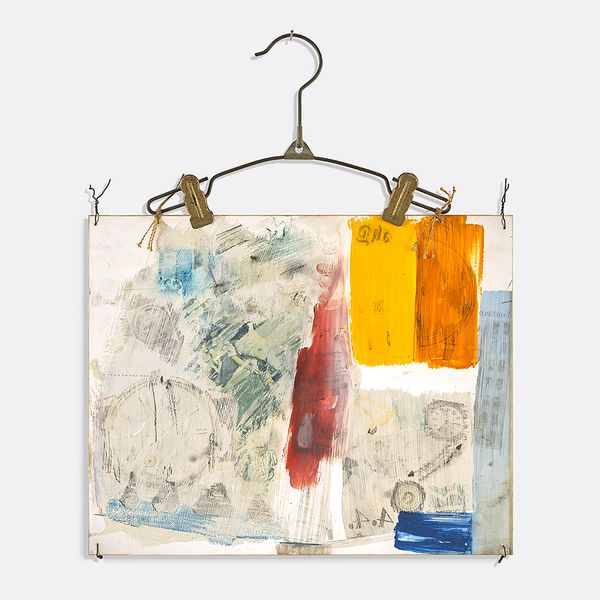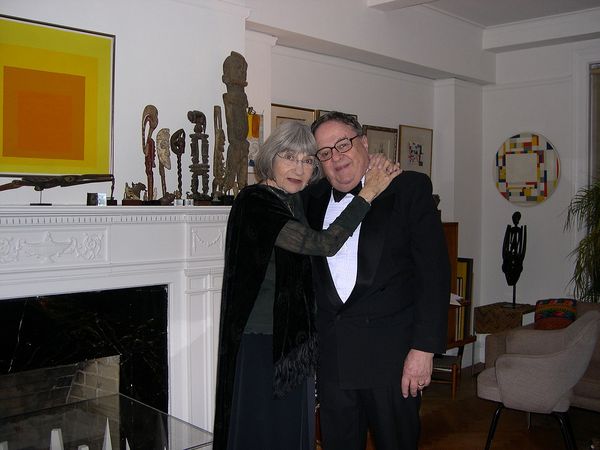Rosa and Aaron Esman at home. Pictured above mantle: Josef Albers, Study for Homage to the Square: Bright, 1962. 20th Century & Contemporary Art Day Sale, Morning Session.
Phillips is pleased to present Property from the Collection of Rosa and Aaron Esman, a collection of over 150 works from their Manhattan residence. Iconic masterworks by Josef Albers, Robert Rauschenberg, and others will be offered in upcoming New York 20th Century & Contemporary Art sales.
Our series of interviews with the daughters of Rosa and Aaron Esman continues below.
Discover Previous Installments:
The World of Rosa and Aaron Esman >
Phillips: Which dealers did your parents have the strongest formative relationships with — and at what stages in the life of the collection?
Susanna: Leo Castelli and Sidney Janis were the most influential and the dealers with whom they had the closest relationship.
Marjorie: Castelli and Emmerich in the glory days of the ‘60s.
Abigail: Leo Castelli, without question, who was a very close friend (and had a heart attack in our living room!). Rosa’s first gallery exhibition was a show of drawings she borrowed from Leo. Her Ten From Leo Castelli portfolio was a project she created for him. He and they socialized often. This was from the early years of their marriage, but they were already collecting. Others include Ileana Sonnabend, André Emmerich, and Ivan Karp (when he worked for Leo). Although they were friends with many other dealers, I would say none had the same influence on their collection as these.
P: Certain key pieces appeared to function in your family home as focal points. Was this planned? Did your parents fall in love with a piece and then find a place for it — or were they actively looking for key crescendo moments?
S: Obviously they knew which works were most important, but they hung works where they fit and where they thought they looked best and actually didn’t move them around too much.
M: Absolutely. They fell in love with a piece and found a place for it.
A: Everything they bought was something they fell in love with and found a place for. Nothing was planned. Nothing was pre-created, the way collections are built now, with checklists of artists and deliberate curation. They saw it, they loved it, they bought it.

Joan Miró, Femmes devant le soleil (Woman in Front of the Sun), 1942. 20th Century & Contemporary Art Day Sale, Morning Session.
P: How did your father’s career as a psychoanalyst inform his eye? And your mother’s as a fine arts editions publisher and gallerist? Did they ever debate and disagree on what to purchase?
S: I would say that my father was the real “collector” and that he was the one who was more interested in having the Pre-Columbian works, African works, and even the Outsider works (which of course were directly related to his profession). My mother loved the Russian Constructivist works but they collected together, and agreed on everything they bought. The only things I heard them argue about was whose fault it was that they didn’t buy…
M: He was largely interested in art forms as an expression of creativity, which was a big interest of his professionally. The creative process was the subject of much of his writing. Her work speaks for itself, she published and represented artists that she valued. I’m not aware of a particular philosophy other than the decision to publish the multiples, which she did, and he supported, in large part because as a young couple with children they couldn’t afford to buy what they wanted. Her goal was to work with artists to create multiple originals that could sell for lower prices for people like themselves.
A: Our father was particularly fond of Surrealist work, and adored Miró and Max Ernst; in addition, he and our mother together became fascinated with Outsider Art and worked together on a catalogue and an exhibition at the gallery in the 1980s. He also translated the biography of Adolf Wölfli from French to English during his sabbatical in 1988. Dada was also a favorite for both of them.
I for one am not sure how Rosa’s “eye” would have been informed by her work as a publisher and gallerist. Rather, I would say it was the other way around: her selections were influenced by her “eye” — what she found amusing, what she found intellectually compelling, what she felt mattered. Those choices would have been made by her, but I can’t imagine one instance where he would have disagreed. They had very similar taste and vision.
If they disagreed on a work, sometimes the one who wanted it would buy it personally rather than them buying it together (which usually meant that our mother paid for it, rather than our father). That didn’t happen often though.

Dr. Aaron Esman with artist and close friend Arman.
P: Which pieces received the most attention from visiting friends and family? And what did your parents see as their proudest highlights?
S: I would say their favorites were probably the Albers, Rauschenberg, and the Miró (which they felt very proud that they acquired when they were young, when they didn’t have much money and my mother was pregnant with me — the oldest) and the Armans because of their close friendship.
Also, they went to galleries every Saturday (often dragging their kids along) and we were dragged on Sundays to museums. When I became director of the John Weber Gallery, I kept toys on my desk so that kids, who were being dragged to galleries like I had been, had something to play with.
M: It’s hard to say what received the most attention, and some of those are no longer in the collection, such as the very large Stella painting that hung in the living room for decades before they sold it. They were proud of the Miró, I think, and the Albers. But I don’t know that they were proud of anything more than anything else.
A: I don’t believe that anything in particular received “the most” attention. As children, we had child friends who were particularly fascinated by certain pieces, but nothing else. The collection itself was their proudest highlight.

Robert Rauschenberg, Bath, 1964. 20th Century & Contemporary Art Evening Sale.
They saw it, they loved it, they bought it.
—Abigail Esman
P: Were there any museums your parents particularly loved visiting, or private collections they admired?
S: They loved private museums (the Frick, Barnes, Clark) but the Met was probably their favorite. My mother had worked at MoMA and of course MoMA was a huge influence on them and on everyone who cares about modern art. More recently, because of my close friendship (and subsequently theirs) with the director of the Whitney, that became a favorite as well. They traveled a lot and went to every museum in every city they visited. They loved them all. My mother was very social, so she of course loved seeing collections in people’s homes.
M: Every museum in every city they ever went to. They loved all of them. He especially liked the small personal collections such as the Frick, the Morgan, the Barnes, the Gardner. But they loved any institution that had art.
A: MoMA, of course (our mother worked there, for René d’Hanoncourt). The Met. The Guggenheim. The Louvre. When they traveled to Europe, they visited every museum they could. They were not particularly struck by any private collections that I can recall.
P: How has growing up in an art-focused family impacted you later in life, both personally and professionally?
S: One year after I graduated from college (with a major in Art History), I got a job at the John Weber Gallery in SoHo, first as a secretary and subsequently as the director. The gallery represented Sol LeWitt and Robert Mangold (among others) and four years later, I left the gallery to work with them privately. I managed their archives, set the prices, edited the catalogues (including the catalogues raisonnés), helped curate their shows and sent the LeWitt crews around the world installing the Wall Drawings. I worked in that capacity with Sol from 1980 until his death in 2007, and still work with Bob, mainly in an archival capacity.
I go to galleries and museums at least once a week and am still very involved in the art world, so my parents’ interest in art had a huge impact on my life.
M: Of the three of us I am the one who has not had an art-focused career. But growing up in an art-focused family certainly gave me not just an appreciation for art but also a sense of the importance and value of art in general. This applies to other art forms besides visual arts, particularly music.
A: I became an art writer because I believed, from my earliest years, that understanding art had a direct connection to empathy (little did I know that research decades later would prove this to be true!) and could replace religion in the way that it can shape psychology; and for a practical reason, because it was what I knew. Later, I became a private art dealer, working often with my mother but not only. That said, as a child, I wanted to be one of two things when I grew up: a writer or a psychologist, echoing my father.
Discover More from 20th Century & Contemporary Art >
Recommended Reading
